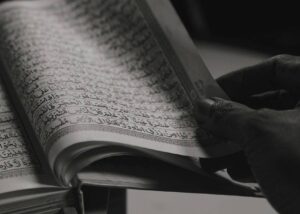Quran
Hadith
Islamic Text
بِسْمِ اللَّهِ الرَّحْمَنِ الرَّحِيمِ
In the Name of Allah Most Merciful Most Kind
Short Answer
According to the strongest opinion in the Hanafi Madhab, the Sajdah in Surah al-Nahl is after verse 50. However, some have said after verse 49. Despite that, verse 50 is the more authentic view.
Quran
وَلِلَّهِ يَسْجُدُ مَا فِي السَّمَاوَاتِ وَمَا فِي الْأَرْضِ مِنْ دَابَّةٍ وَالْمَلَائِكَةُ وَهُمْ لَا يَسْتَكْبِرُونَ (49) يَخَافُونَ رَبَّهُمْ مِنْ فَوْقِهِمْ وَيَفْعَلُونَ مَا يُؤْمَرُونَ (50)
And to Allah prostrates whatever is in the heavens and the earth of living creatures and the angels. They are not arrogant. They fear their Lord above them and do what they are commanded. (Surah al-Nahl, 49 – 50).
Sajdah is after verse 50
In the Quranic verse above, Allah Most High speaks about those that are in the heaven and earth making Sajdah (prostration) to Him. The blessed Prophet ﷺ instructed us to make Sajdah at such points in the Holy Quran. Therefore, there is a verse of Sajdah in Surah al-Nahl.
However, there is some difference amongst the scholars with regards to exactly where Sajdah is required in Surah al-Nahl. Is it after verse 49 or verse 50? We will see that in the Nusoos (texts) below, the sounder opinion is verse 50:
وَمِنْهُنَّ النَّحْلُ وَمَوْضِعُ السُّجُودِ مِنْهَا عِنْدَ قَوْلِهِ تَعَالَى {وَلِلَّهِ يَسْجُدُ مَا فِي السَّمَوَاتِ وَمَا فِي الْأَرْضِ مِنْ دَابَّةٍ} إِلَى قَوْلِهِ {يُؤْمَرُونَ} [النحل: 50]. (شرح معاني الآثار)
And among them (the Ayaat of Sajdah) is in (Surah) al-Nahl. The place of prostration therein is at the Almighty’s saying: And to Allah prostrates whatever is in the heavens and the earth of living creatures. Up to: They are commanded. (al-Nahl: 50). (Imam Abu Jafar al-Tahaawi, Sharh Ma’aani al-Aathaar).
وَالنَّحْلِ عَقِبَ (يُؤْمَرُونَ)، وَقِيلَ: (يَسْتَكْبِرُونَ). (مرقاة المفاتيح شرح مشكاة المصابيح)
In (Surah) al-Nahl after: They are commanded. And it is said (in a weaker opinion, after) Arrogant. (Imam Ali al-Qari, Mirqaat al-Mafateeh).
“والنحل” {وَلِلَّهِ يَسْجُدُ مَا فِي السَّمَاوَاتِ وَمَا فِي الْأَرْضِ مِنْ دَابَّةٍ وَالْمَلائِكَةُ وَهُمْ لا يَسْتَكْبِرُونَ يَخَافُونَ رَبَّهُمْ مِنْ فَوْقِهِمْ وَيَفْعَلُونَ مَا يُؤْمَرُونَ} [النحل: 49، 50]. (مراقي الفلاح شرح متن نور الإيضاح)
And in (Surah) al-Nahl. And to Allah prostrates whatever is in the heavens and the earth of living creatures and the angels. They are not arrogant. They fear their Lord above them and do what they are commanded. (Imam Hasan bin Amar, Maraaqi al-Falah).
Hanafis prefer caution
Hanafi scholars tend to take a more cautious approach when it comes to specifying the place of Sajdah in a Surah. They do this so that it is valid by agreement. For example, when asked ‘where is the Sajdah in Surah al-Nahl?’ They would prefer to reply verse 50 instead of 49.
This is because performing Sajdah after verse 50 will be valid for both. But if one were to perform Sajdah after 49 then that would work for 49 but not 50. Therefore, performing Sajdah after verse 50 covers both possibilities and is thus more cautious.
Conclusion
The strongest position in the Hanafi Madhab is that the Sajdah in Surah al-Nahl is after verse 50. This is also the more cautious approach. Although some Hanafi scholars did hold the view that it is after verse 49, this is a weaker opinion.
One may ask: why are scholars differing over the Holy Quran? Isn’t the Quran agreed upon?
Yes, of course, the Quran is agreed upon. However, this difference is not about the Holy Quran and the words or verses in it. Rather, this difference is about a Prophetic practice; Did the Prophet ﷺ require us to make Sajdah after verse 49 or 50?
This is where the difference exists.
Alhamdulillah, we do not differ over the Holy Quran itself.
Despite that, we sometimes have different views regarding matters related to the Holy Quran. For example, the explanation of a particular verse.
And Allah Most High Knows Best.
–Answered by Shaykh Noorud-deen Rashid (18.03.24)



